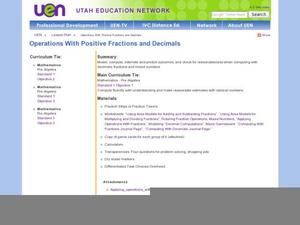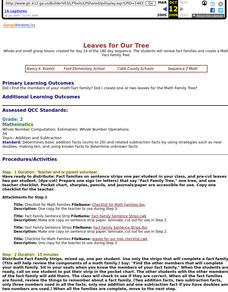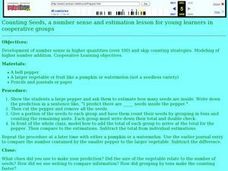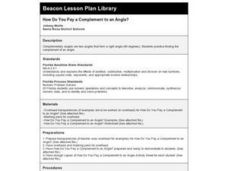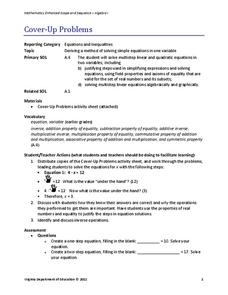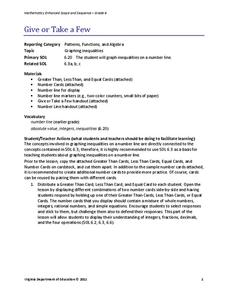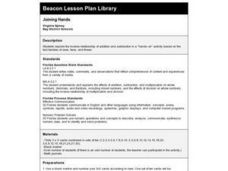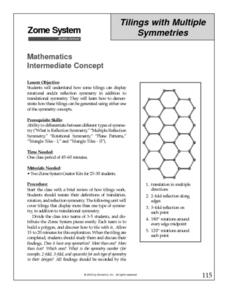Curated OER
Operations with Positive Fractions and Decimals
Explore the concept of fractions and decimals! In this fractions and decimals instructional activity, pupils use fraction tiles to express fractions. They play a fraction review basketball game where when a team gets a question correct...
Curated OER
Leaves for Our Tree
Young mathematicians review fact families and create a Math Fact Family Tree. This clever lesson plan includes some excellent printouts that support the lesson.
Curated OER
Multiplication: A Treasure Hunt to Two and Three Digit by One Digit Multiplication
Here is a math lesson which has learners practice multiplying two and three digit numbers by one digit numbers. They discuss multiplication strategies and use those strategies to play a game.
Curated OER
Counting Seeds
Students practice skip counting strategies, estimation, and higher number addition. They estimate the number of seeds in bell pepper, and count seeds in groups of tens and ones after the teacher removes seeds from the pepper.
Utah Education Network (UEN)
Linear Relationships: Tables, Equations, and Graphs
Pupils explore the concept of linear relationships. They discuss real-world examples of independent and dependent relationships. In addition, they use tables, graphs, and equations to represent linear relationships. They also use ordered...
Curated OER
How Do You Pay a Complement to an Angle?
Students observe and solve examples of the complementary angle theorem. They complete the How Do You Pay a Complement to an Angle worksheet, and write a response in their math journal.
Curated OER
Understanding Whole Numbers
In this understanding whole numbers worksheet, 4th graders use a computer program for instruction, then answer 16 problems about addition and subtraction.
Virginia Department of Education
A Mystery to Solve
Investigate field properties of real numbers. Scholars use a table for a given operation to determine the identity element. They use the same table to find a missing value in an equation.
EngageNY
An Appearance of Complex Numbers 1
Complex solutions are not always simple to find. In the fourth lesson of the unit, the class extends their understanding of complex numbers in order to solve and check the solutions to a rational equation presented in the first lesson....
Curated OER
Order of Operations
Fourth graders develop an understanding of the order of operations by relating to putting on a sock and shoe. In this order of operations lesson, 4th graders a mnemonic device to complete math examples. Students can communicate the...
IMSA
Geometric Transformations with Matrices
In this math worksheet, learners find the values associated with the geometric transformations. They read the instruction sheet for completing matrices with translations, rotations, reflections, and scaling by adding and multiplying...
Lesson This!
Fraction Fruit
Discover the concept of fractions by using fruit as a model. Scholars discover fractions are part of a whole, similar to the pieces of fruit which are placed in front of them. They then cut up several different types of fruit and discuss...
Curated OER
Accounting -- Journalizing Sales and Cash Payments
Learners brainstorm a list of what they believe a customer is. In groups, they practice journaling sales to a customer who pays with cash or with credit. To end the lesson, they discover the proper way to prove cash payments at the end...
Curated OER
Popsicle Stick Regrouping Fun
Students demonstrate regrouping in subtraction. In this math computation lesson, students use popsicle sticks to practice the regrouping strategy. Students practice several examples of regrouping problems in small groups.
Curated OER
Using a Hundreds Chart
Youngsters participate in three activities using the hundreds chart. They will choose numbers to add up to one hundred. Whoever gets the most combinations wins. Two variations of the game are supplied.
Curated OER
100 More 100 Less
Third graders review the concept of place value and number sense. With a partner, they are given four cards with numbers on them. Using the cards, they practice making new numbers and completing addition and subtraction to find the...
Virginia Department of Education
Cover Up Problems
Don't cover up this resource — use it out in the open! Pupils learn how to cover up various parts of a linear equation in order to help solve the equation. A worksheet of problems provides practice with this skill.
Virginia Department of Education
Inductive and Deductive Reasoning
Introduce pupils to the two types of reasoning, inductive and deductive. Classmates work in pairs or small groups to learn the difference between the two and apply these reasonings to develop valid conclusions.
Virginia Department of Education
Give or Take a Few
Young mathematicians extend their knowledge of rational numbers on a number line to graph inequalities by first using number cards to compare rational numbers. They finish by using similar reasoning to graph inequalities on a number line.
Savannah-Chatham County Public School System
Using Self-Control
Everyone gets frustrated from time to time. You may not be able to control the way you feel, but you can definitely learn to control the way you act in times of frustration. A helpful lesson on self control encourages your class to stop,...
Curated OER
Joining Hands
Second graders explore the inverse relationship of addition and subtraction in a "hands-on" activity based on the fact families of ones, twos and threes.
Curated OER
Tilings with Multiple Symmetries
Students explore how some tilings can display rotational and/or reflection symmetry in addition to translational symmetry. Students demonstrate how these tilings can be generated using either one of the symmetry concepts and Zome System...
Curated OER
Simplify Expression Using the Order of Operations
Allow learners to explore both the right and wrong way of completing equations with the order of operations. They discuss how the order in which operations are performed affects the outcome of a problem. A fun "trick" using order of...
Berkshire Museum
Adopt a Schoolyard Tree
Help young scientists connect with nature and learn about trees with a fun life science lesson plan. Heading out into the school yard, children choose a tree to adopt, taking measurements, writing descriptions, and drawing sketches of it...
